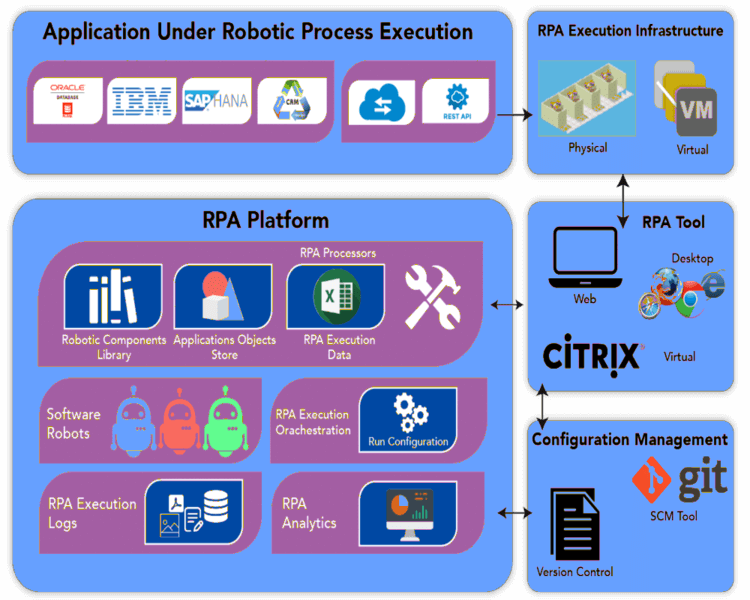RPA Architecture
The architecture of Robotic Process Automation (RPA) includes several different tools, platforms, and various infrastructure elements. They all together form a complete RPA tool. To understand this in detail, check out the following image that gives a brief description of a typical RPA solution and its architecture:

Let us try to understand in detail about each of the available blocks in the architecture diagram.
Application under Robotic Process Execution
RPA is considered as a well-suited technology for enterprises and enterprise applications. Enterprise applications may include SAP, Siebel, or other record processing applications like Mainframes. Such types of applications are generally data-intensive, data-centric, and loaded with repetitive tasks.
RPA Tools
The capabilities that are usually seen in any RPA tool are described below:
- RPA tools allow automating a variety of applications in different environments (i.e., Desktop, Web, Citrix, etc.).
- RPA tools allow developing software bots that can be trained by recordings, configuring, and enhancing the programming logic such as loops and conditions, etc.
- RPA tools allow building reusable components that can be applied to multiple robots, which ensures the same time modularity, faster development, and easier maintenance.
- RPA tools allow the reading and writing of different data sources while executing the software robots.
- RPA tools allow building shared applications, user interface object stores, and object repositories containing object locators.
RPA Platform
RPA software bots in the cloud act like they are stored in a shared repository, which can be further shared across libraries of software robots. RPA platform helps in scheduling, distributing, and monitoring the execution of software robots. It also provides the ability to develop meaningful insights of software bots and their execution statistics.
RPA Execution Infrastructure
RPA execution infrastructure is defined as a bank containing physical or virtual lab machines that can be controlled on the basis of usage patterns. The process of scaling up or down the number of machines parallelly for automating the task can also be performed. This process does not require any further human interaction, so it can be left unattended for as long as needed.
Configuration Management
Configuration Management is used for stating the version of RPA assets as the underlying application. It helps in developing the software robots and also updating them to newer versions. It also helps in branching and merging of RPA robots since they are reusable across the libraries.
Therefore, RPA is a combination of several different layers of applications and tools that are combined to make it a complete system and the architecture.
